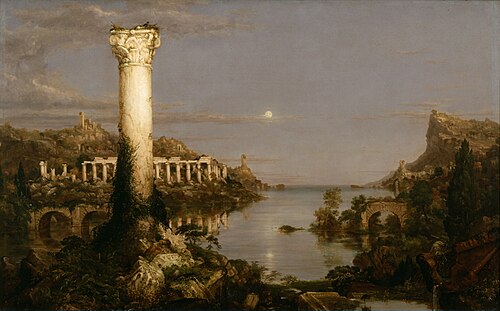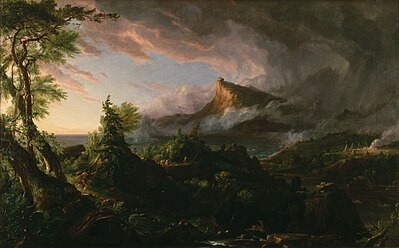Talk:The Course of Empire (paintings)
| This article is rated Start-class on Wikipedia's content assessment scale. It is of interest to the following WikiProjects: | ||||||||
| ||||||||
untitled[edit]
Hey, so just created the page on 1/27/07. Mdiamante 06:46, 27 January 2007 (UTC)
This page should probably reference Bishop Berkeley's line "Westward, the course of empire takes its way". —Preceding unsigned comment added by 70.179.20.157 (talk) 13:53, 14 February 2009 (UTC)
The Paintings[edit]
How big are they. You know, the Size? Anyone ... anyone ... Buhler? 71.164.128.167 (talk) 05:00, 10 March 2011 (UTC)
- This page needs most of the content from http://www.explorethomascole.org/tour/items/69/series/; site run by Historicusinc.com for their client, ThomasCole.org, "an affiliated site of the National Park Service". Two items in particular: 1. The title of this series of paintings is taken from Bishop George Berkeley's poem "Westward the course of empire takes its way", 2. The sizes, dates, and composition of the paintings: All are "Oil on canvas", "The Savage State" 1834, 39½ x 63½ in., "The Arcadian or Pastoral State" 1834, 39½ x 63½ in., "The Consummation of Empire" 1836, 51 x 76 in., "Destruction" 1836, 39½ x 63½ in., "Desolation" 1836, 39½ x 63½ in. 71.164.128.167 (talk) 19:43, 20 March 2011 (UTC)
- I added the sizes and dates to the image thumbnails. Feel free to move them around if you find a better solution. Also, be bold if you think any change would make the article better! Cheers, jonkerz♠ 20:23, 20 March 2011 (UTC)
- Thanks jonkerz♠. I'm pretty bold, for a n00b -- I thought anyone watching this page would know better how & where to insert the info. I was right. Again. ;) BTW, an excellent Cultural Reference would be here: http://courseofempire.com/mp3/ 71.164.128.167 (talk) 16:02, 23 March 2011 (UTC)
- I added the sizes and dates to the image thumbnails. Feel free to move them around if you find a better solution. Also, be bold if you think any change would make the article better! Cheers, jonkerz♠ 20:23, 20 March 2011 (UTC)
Latin quote[edit]
"Sic transit gloria mundi" is directly connected to these paintings how? It looks like pure editorial to me. 71.164.128.167 (talk) 19:44, 20 March 2011 (UTC)
- It is not removed. jonkerz♠ 20:24, 20 March 2011 (UTC)
- And yet, it is gone. Thanks ... As everyone knows, there are dozens, if not hundreds of sites that copy WP content -- I found many that have these descriptions of the paintings, most of which not only included the Latin quote, but an English translation of it. All the descriptions were added on 1 April 2007 by 76.201.155.223, and I could not find the text existing any earlier anywhere else that could be dated, so hopefully it is original -- nice job & thanks to 76.201.155.223. BTW jonkerz♠, how did your edits timestamp an hour before mine‽‽ 71.164.128.167 (talk) 15:35, 23 March 2011 (UTC)
- The timestamp in the article history or on this talk page? Your timestamp is before mine on the talk page (19:44 vs. 20:24 in the above messages) because you edited before me; my timestamp is earlier in the article history because on that occasion I edited before you, at least according to my memory and the page's history. Are we looking at different logs‽‽ jonkerz♠ 21:17, 23 March 2011 (UTC)
- And yet, it is gone. Thanks ... As everyone knows, there are dozens, if not hundreds of sites that copy WP content -- I found many that have these descriptions of the paintings, most of which not only included the Latin quote, but an English translation of it. All the descriptions were added on 1 April 2007 by 76.201.155.223, and I could not find the text existing any earlier anywhere else that could be dated, so hopefully it is original -- nice job & thanks to 76.201.155.223. BTW jonkerz♠, how did your edits timestamp an hour before mine‽‽ 71.164.128.167 (talk) 15:35, 23 March 2011 (UTC)
File:Cole Thomas The Course of Empire The Savage State 1836.jpg to appear as POTD soon[edit]
Hello! This is a note to let the editors of this article know that File:Cole Thomas The Course of Empire The Savage State 1836.jpg will be appearing as picture of the day on December 9, 2019. You can view and edit the POTD blurb at Template:POTD/2019-12-09. If this article needs any attention or maintenance, it would be preferable if that could be done before its appearance on the Main Page so Wikipedia doesn't look bad. :) Thanks! Cwmhiraeth (talk) 10:49, 27 November 2019 (UTC)
Featured picture scheduled for POTD[edit]
Hello! This is to let editors know that the featured picture File:Cole Thomas The Course of Empire Destruction 1836.jpg, which is used in this article, has been selected as the English Wikipedia's picture of the day (POTD) for August 16, 2021. A preview of the POTD is displayed below and can be edited at Template:POTD/2021-08-16. For the greater benefit of readers, any potential improvements or maintenance that could benefit the quality of this article should be done before its scheduled appearance on the Main Page. If you have any concerns, please place a message at Wikipedia talk:Picture of the day. Thank you! Cwmhiraeth (talk) 10:26, 7 August 2021 (UTC)

|
|
Destruction is the fourth in a series of five oil-on-canvas paintings entitled The Course of Empire, created by the American artist Thomas Cole between 1833 and 1836. The series, now in the collection of the New-York Historical Society, depicts the growth and fall of an imaginary city, situated at the lower end of a river valley. In this painting, a fleet of enemy vessels have sailed up the river, bringing warriors who have overthrown the city's defenses and are ransacking the city and killing and raping its inhabitants. Painting credit: Thomas Cole
Recently featured:
|
Featured picture scheduled for POTD[edit]
Hello! This is to let editors know that File:Cole Thomas The Course of Empire Desolation 1836.jpg, a featured picture used in this article, has been selected as the English Wikipedia's picture of the day (POTD) for June 1, 2022. A preview of the POTD is displayed below and can be edited at Template:POTD/2022-06-01. For the greater benefit of readers, any potential improvements or maintenance that could benefit the quality of this article should be done before its scheduled appearance on the Main Page. If you have any concerns, please place a message at Wikipedia talk:Picture of the day. Thank you! — PerfectSoundWhatever (t; c) 17:31, 21 May 2022 (UTC)

|
|
Desolation is the fifth in a series of five oil-on-canvas paintings entitled The Course of Empire, created by the American artist Thomas Cole between 1833 and 1836. The series, now in the collection of the New-York Historical Society, depicts the growth and fall of an imaginary city, situated at the lower end of a river valley. In this painting, the remains of the city are depicted decades after its destruction by invaders, with the landscape beginning to return to wilderness. Painting credit: Thomas Cole
Recently featured:
|
A question about Cole's description[edit]
In Cole's description of The Consummation of Empire there's this sentence: "The conqueror, robed in purple, is mounted in a car drawn by an elephant, and surrounded by captives on foot,"
Where are the captives in the painting, anyone know? MrThe1And0nly (talk) 07:36, 15 October 2023 (UTC)
I've added L'Allegro[edit]
Seems to be similar enough to warrant a mention here. Since I don't know anything about the painting, I've limited myself only to the description of what is demonstrably visible in the painting. I hope this isn't an overreach and fits the article. Personally I think it's a beneficial addition. Someone knowledgeable may feel free to edit however they see fit. MrThe1And0nly (talk) 11:04, 15 October 2023 (UTC)


